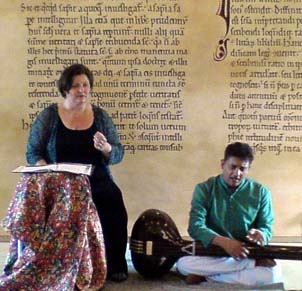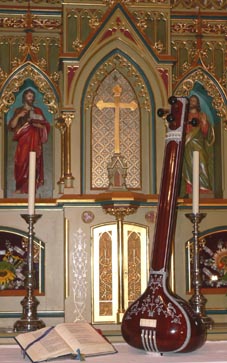Dhrupad & Hildegard

Hildegard von Bingen, The great German seer described music as a means of recapturing the original joy and beauty of paradise. Presenting a vast vision of the cosmos, her music goes to the roots of what are sound, voice and hearing. Her music often sounds like what we imagine the singing of angels to be. Her chants are rich in mystical images, and her melodies are elaborate, with florid melodic contours, ornamented inflections, and wide ranges.

Dhrupad is the oldest surviving tradition of classical music in India. It originated in the chanting of hymns and developed under the patronage of imperial courts in India over many centuries into a classical form, with its own complex grammar and aesthetics. In this style of singing the singer develops the inner resonance of the body, and can make the sound resonate and flow freely through the entire region from navel to head. This enables the singer to use a vast palette of subtle tone colours and microtonal shades. In this music the notes are not treated as fixed points, but as fluid entities with infinite microtonal shades.

Dhrupad & Hildegard have surprisingly a lot in common both in form and spirit. Belonging roughly to the same period, the melodic phrases of Dhrupad and those of Hildegard’s compositions have a similar structure. Hildegard’s modal melodic lines have the feel of Indian ragas. It is obvious that about 1000 years ago the sacred music of Europe and that of India had much in common though separated by a vast geographical distance.
Because of these similarities a harmonious dialogue is possible between the melodic lines of Hildegard and the improvisations of Dhrupad. Ashish Sankrityayan has done many concerts of dhrupad in dialogue with the songs of Hidegard in churhces and other venues, with Hindegard singers like Dorthe Rose Svastha and Inge Brink Hansen
-
- Dhrupad Alap, Dhamar in Bageshree
- Alap in Raga Bihag
- Alap Yaman Shloka/Mantra Syllables
- Dhrupad Chowtal Raga Yaman
- Dhrupad Dhamar Raga Khamaj
- Dhrupad & Swedish Folk Kulning
- Kathak Dance With Vidyagauri Adkar
- Dhrupad & Odissi
- Raga Bageshree
- Documentary Dhrupad: The Call of the Deep Excerpt 1
- Documentary Dhrupad: The Call of the Deep Excerpt 2
-
- Baba Behram Khan
- Ustad Zakiruddin Khan
- Ustad Allabande Khan
- Ustad Ziauddin Khan
- Ustad Nasiruddin Khan
- Ustad Rahimuddin Dagar
- Ustad Imamuddin Khan
- Ustad Hussainuddin Dagar
- Ustad Nasir Moinuddin Dagar
- Ustad Nasir Aminuddin Dagar
- Ustad Zia Mohiuddin Dagar
- Ustad Rahim Fahimuddin Dagar
- Ustads Nasir Zahiruddin & Nasir Faiyazuddin Dagar
- Ustad Zia Fariduddin Dagar
- Ustad Hussain Sayeeduddin Dagar
- Dagar Brothers